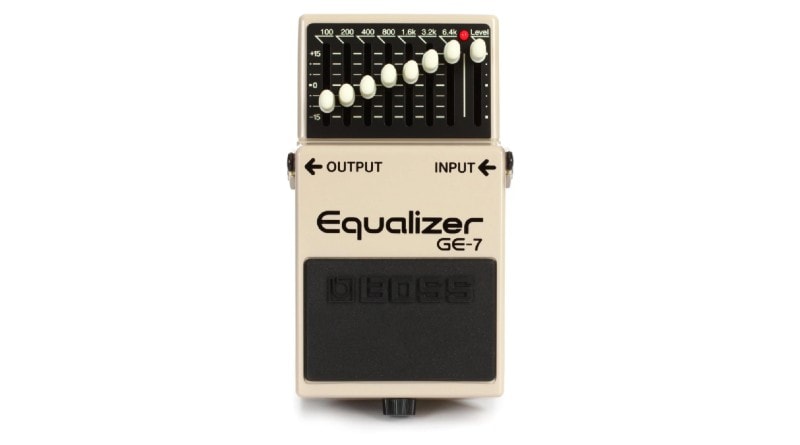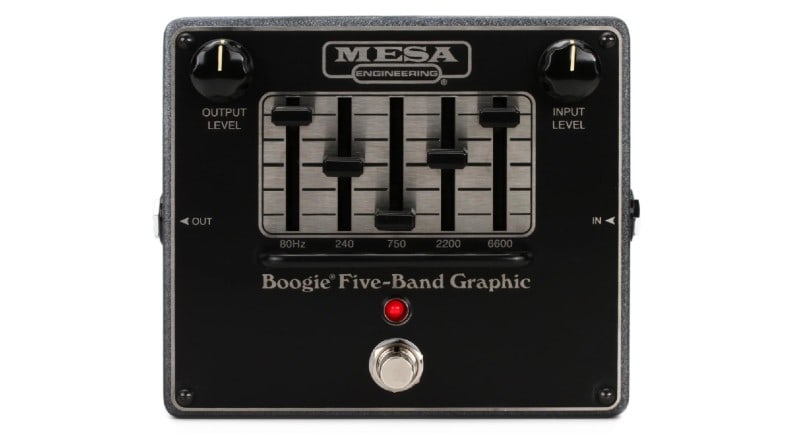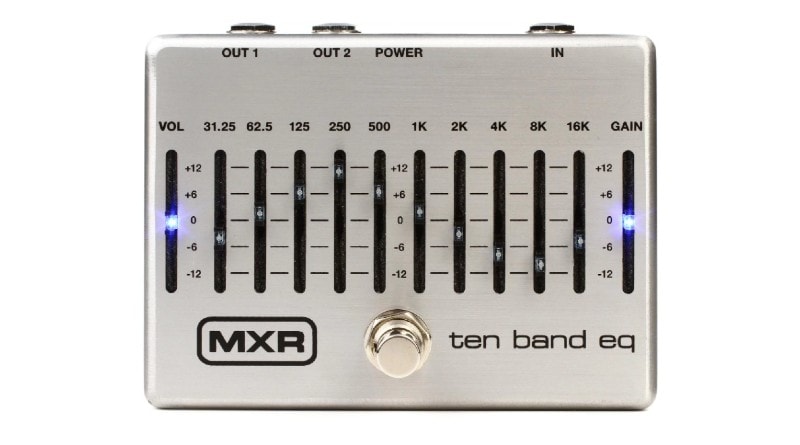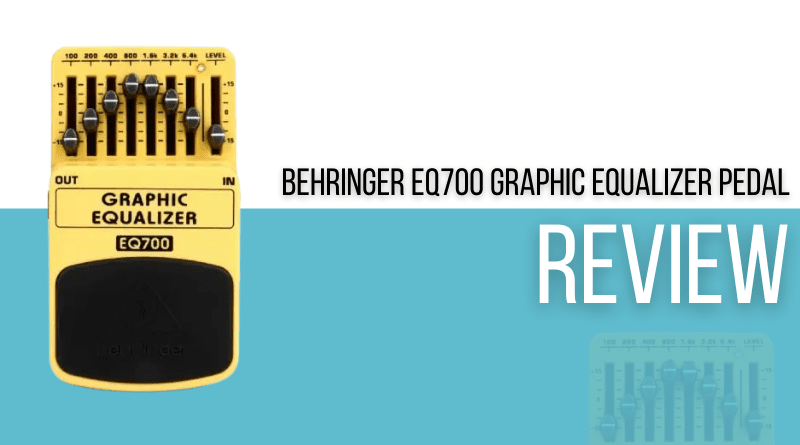Graphic EQ pedals are probably one of the most underutilized tools out there when it comes to getting the perfect sound. All too often, players double down on FX trying to sculpt their sound to perfectly match what they’re looking for. When used correctly, a graphic EQ pedal can completely change everything, letting you shape your sound to the occasion.
The Behringer EQ700 is another in their line of budget pedals inspired by famous models from well known brands. In this case, the Boss GE-7, an industry standard EQ pedal, was Behringer’s muse. The EQ700 certainly looks like the real deal, but can it match the level of tone control provided by the Boss GE-7? Keep on reading to see what we discover.
Read more about our review process.
Contents
Behringer EQ700 Graphic Equalizer: Who Is This Pedal For?
Graphic EQ pedals like this have traditionally been marketed at advanced level players looking to fine tune their sound beyond their guitar’s tone knobs and their amp’s bass and treble controls. These pedals don’t have the big impact that a distortion or a reverb pedal would, so beginners are usually more inclined to spend their money on other FX.
Behringer’s approach, however, is to make all of their pedals affordable for every player. So, while a beginner may have previously saved to spend $100 on one pedal, that player could buy 3 or 4 Behringer pedals for the same money, and they may just include something like this EQ700 in their selection.
Behringer EQ700 Graphic Equalizer: Appearance / Features / Controls
Addressing the elephant in the room – yes, like other Behringer pedals, it is made with a plastic case. In reality, however, this should not matter to the average guitarist. The construction of the EQ700 Graphic Equalizer is more than sufficient to survive bedroom use and light gigging. If you’re particularly harsh on your gear, you may want to consider something else, such as one of the alternative pedal suggestions later in the review.
The EQ700 is finished in a light yellow shade, so it does stand out a little from the off white finish on the Boss GE-7.
Layout is standard for a graphic EQ pedal. The on/off activation is taken care of by a hinged pedal switch with a substantial rubber pad for grip and protection from wear and tear. There is a single line in, and a single line out jack. There are 7 EQ controls which allow you to boost or cut volume on those individual frequencies. This allows you to shape your sound by boosting or scooping particular ranges. For example, if you’re a metal player and you’re looking for scooped mids, you can cut back the level on your mid range frequencies, and either leave bass and treble neutral, or make the scoop more obvious by boosting them.
As well as individual frequency controls, this pedal also has a master level boost/cut control, which controls the volume output from the pedal.
Behringer EQ700 Graphic Equalizer: Performance / Sound
Battery installation was the first task before we could get the review underway. If you’re at all familiar with Behringer pedals, you probably already know that they aren’t the most user friendly pedals when it comes to battery installation. To do so you’ll need to take 2 thin implements, such as screwdrivers, and depress the pedal hinge springs before pulling up on the pedal itself. Every time you take on this task you put the plastic structure at risk of breakage, so, we thoroughly recommend investing in the Behringer PSU-SB 9V power adapter to eliminate the need to change batteries.
To see if this pedal colored our sound in any way before adjusting any frequencies, we played direct from the guitar to the amp for a reference tone. Once we’d set the reference tone, we plugged in the EQ700, with all levels set to 0 and compared it to the dry tone. First indications were good, and we were happy that the pedal on neutral settings did not alter the tone from our dry signal.
We also noted that after turning this pedal on, there was no additional noise or fizz from the amp – definitely a good sign. It wasn’t completely without noise, for example, when dropping the bass and increasing the treble, there was a much more pronounced hum, although it wasn’t obtrusive, and was only a little noisier than its rival, the Boss GE-7.
The 7 adjustable frequencies are 100Hz, 200Hz, 400Hz, 600Hz, 1.6kHz, 3.2kHz, and 6.4kHz. Each of the channels can be cut or boosted by up to 15dB. Playing with the various settings on this pedal was really a lot of fun. When we trimmed the bass and added to the treble, we got a bright, spanky, almost Telecaster like sound from our Epiphone SG!
Next, we scooped the mids out and increased bass and treble just a touch. This gave us a beautiful, warm blues tone when played with low gain and no distortion, and with the distortion on and gain cranked, the tone was perfect for doom metal with the same EQ settings.
We did try to boost the bass and drop the mids and trebles, but we only got mud for that setting. There are few, if any real world applications for such an EQ setting on an guitar, but it was still a fun experiment to see what would happen.
Another nice feature of the Behringer Graphic Equalizer pedal is just how easy it was to cut out unwanted acoustic feedback. When we experienced feedback, the trick was to gently cut the 400Hz frequency until it dissipated.
Our biggest takeaway was how well this pedal was able to recover the tones that you’d normally lose by turning an amp down to bedroom volume levels. Even with super quiet levels, the EQ700 kept tones fat without being a nuisance to others.
Other Graphic EQ Pedals to Consider
The Behringer EQ700 is a well equipped pedal at a great price, but if you’re looking for something else, there are still some great alternatives on the market, including:
Boss GE-7 EQ Pedal

The GE-7 is the obvious inspiration for the Behringer EQ700. The sound is incredibly similar to the EQ700, but it has the advantage of being made with a metal shell. If you like the sound of the Behringer, but you spend a lot of time on the road, and you’re concerned about breaking a plastic pedal, the Boss GE-7 is a great choice.
Mesa/Boogie Boogie 5 Band Graphic EQ

Mesa/Boogie amps and accessories are world renowned for their incredible engineering and sound quality, and that’s exactly what you get in this EQ pedal. It doesn’t have the same range of control as the Behringer, having just 5 bands, rather than 7, but if you’re looking for peerless sound quality, there’s no finer pedal.
MXR M108S Ten Band EQ Pedal

If 7 frequency control isn’t enough for you and you’re looking for even finer control, take a look at this MXR graphic EQ. It features 12 dB of boost/cut control for its 10 channels, over frequencies ranging from 31.25Hz to 16kHz. Like most premium pedals, it has a metal enclosure, and rather than a hinged pedal, it features a stomp box style button control.
Final Thoughts on the Behringer EQ700 Graphic Equalizer
Once again, Behringer has proven that they can make a great pedal at a great price. If you’ve never played with a graphic EQ pedal before, it makes all the sense in the world to start out with something like the Behringer EQ700 – at such a low price, you can test the water to see if it’s able to help you achieve what you’re looking for sound wise. It has no less control than the Boss pedal it is based upon, and truthfully, there is very little discernable difference in sound between the two. In all, this Graphic Equalizer pedal comes highly recommended.
Check out these other articles you might like:


